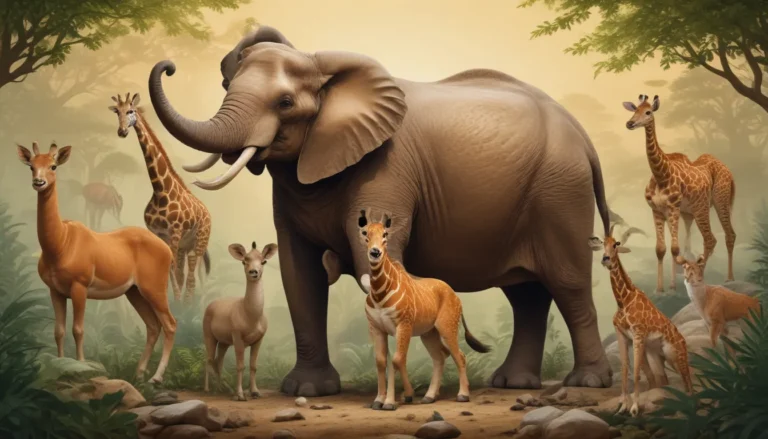The pictures we use in our articles might not show exactly what the words say. We choose these pictures to make you interested in reading more. The pictures work together with the words but don’t take their place. The words still tell you the important facts.
Are you curious about what sets Africa's wildlife apart from the rest of the world? From the iconic lions prowling the savannahs to the elusive leopards hidden in the shadows, the continent is teeming with fascinating creatures. Africa's wildlife isn't just about the big and bold; it's a diverse ecosystem where every animal plays a vital role. So, what are some mind-blowing facts about these animals that call Africa home? Get ready to be astonished as we delve into 16 incredible facts about Africa's wildlife. From the industrious dung beetles to the majestic giraffes with their towering necks scanning the treetops, each fact showcases the wonders of nature in Africa. Are you prepared to get up close and personal with the continent's most iconic inhabitants? Let's embark on this mesmerizing journey together!
Discovering the Wonders of Africa’s Wildlife
Africa's wildlife is renowned for its diversity, featuring unique ecosystems that support a wide array of animal species. From the vast savannahs to dense forests and expansive deserts, each habitat provides a home for creatures that have evolved to thrive in their specific surroundings. This rich biodiversity is what makes Africa's wildlife truly exceptional, drawing visitors from around the world to witness nature in its purest form.
- Africa is home to the famous "Big Five": lions, leopards, rhinoceroses, elephants, and Cape buffaloes, making them sought-after sights for wildlife enthusiasts.
- The continent boasts the African elephant, the largest land animal globally, which plays a crucial role in preserving the biodiversity of its habitat.
The Spectacular Serengeti Migration
One of Africa's most mesmerizing natural events is the annual migration of wildebeests, zebras, and other grazing herbivores across the Serengeti-Mara ecosystem. This massive movement is driven by the search for fresh grazing and water, attracting predators and creating a dynamic wildlife spectacle.
- Over 1.5 million wildebeests and 200,000 zebras partake in this migration, making it one of the planet's largest animal migrations.
- The migration spans a circular route of approximately 1,200 miles, encountering various challenges such as crocodile-infested rivers and predators like lions and hyenas.
Upholding Conservation Efforts for Africa’s Wildlife
With habitat destruction, poaching, and climate change posing significant threats to Africa's wildlife, conservation initiatives are more crucial than ever. Numerous organizations and governments are collaborating to safeguard these animals and their habitats, ensuring their survival for generations to come.
- Anti-poaching units and wildlife reserves have been established across the continent to protect endangered species and combat illegal wildlife trade.
- Community-based conservation projects involving local communities in wildlife protection efforts and sustainable tourism have gained traction, providing economic benefits while minimizing environmental impact.
Unveiling Intriguing Facts About Specific African Animals
Africa's wildlife isn't just vast; it also includes some of the planet's most captivating creatures, each with unique traits and behaviors that contribute to the complexity of their ecosystems.
- The cheetah holds the title of the world's fastest land animal, capable of reaching speeds up to 75 mph in short bursts.
- Giraffes, the tallest mammals on Earth, possess a unique cardiovascular system, with a powerful heart pumping blood up to their brains, standing six feet above their bodies on average.
Understanding the Role of African Animals in Ecosystems
Each animal in Africa plays a vital role in maintaining the health and balance of its ecosystem. Predators help control herbivore populations, preventing overgrazing, while herbivores aid in seed dispersal, contributing to the regeneration of plant life.
- Elephants are recognized as "ecosystem engineers" for their ability to modify their environment by uprooting trees and creating waterholes that benefit other species.
- Termites, often underestimated, are crucial for soil health, aerating the soil through their mounds and increasing fertility to support plant growth.
Addressing the Impact of Climate Change on Africa’s Wildlife
Climate change poses a significant threat to Africa's wildlife, impacting habitats and food availability. As temperatures rise and weather patterns shift, animals are compelled to adapt, migrate, or face the risk of extinction.
- Changes in rainfall patterns and increased droughts directly affect water-dependent species like hippos and aquatic birds, diminishing habitats and food sources.
- The melting of mountain glaciers, such as those on Mount Kilimanjaro, impacts downstream water supplies, affecting both animals and human populations dependent on them.
Embarking on a Safari Through African Wildlife Facts
We've embarked on a journey through Africa's vast landscapes, unveiling the wonders of its wildlife. From the regal lions symbolizing strength and courage to the complex social structures of elephants and the elusive leopards, each animal offers something unique. The unmatched speed of cheetahs, the challenges rhinoceroses face, the survival strategies of giraffes, and the hidden power of hippos all contribute to the intricate web of life in Africa. The diverse birdlife adds a vibrant layer to this ecosystem, showcasing nature's beauty and complexity. Every fact about these animals entertains and educates, underscoring the importance of conservation efforts for future generations to witness these marvels. Africa's wildlife stands as a testament to the wonder and resilience of nature.
Frequently Asked Questions
Q: What makes African elephants unique among other species?
A: African elephants stand out due to their enormous ears, resembling the African continent, which helps them stay cool under the hot sun. They are also the largest land animals globally.
Q: Can you spot lions during the day in Africa?
A: Spotting lions during the day can be challenging as they are primarily nocturnal creatures. They spend most daylight hours resting.
Q: How fast can a cheetah really go?
A: Cheetahs can reach speeds up to 75 mph, built for short bursts of speed to catch their prey.
Q: Are giraffes mute?
A: Giraffes aren't entirely mute; they communicate through infrasound, below the range of human hearing.
Q: What's special about the African penguin?
A: African penguins are unique for being one of the few penguin species found in warmer climates, notably in Southern Africa.
Q: How do rhinos use their horns?
A: Rhino horns are crucial for defense, dominance battles, and digging for water and roots.
Q: Why are African wild dogs successful hunters?
A: African wild dogs have an impressive hunting success rate due to their teamwork and stamina, allowing them to outsmart their prey.
Conclusion
Our commitment to delivering trustworthy and engaging content underscores our dedication to quality and authenticity as we explore and learn together. Each fact shared on our platform is contributed by real users, ensuring a wealth of diverse insights and information. Trust in our commitment to quality as we continue to uncover the wonders of Africa's wildlife and the vital importance of conservation efforts for the future.






